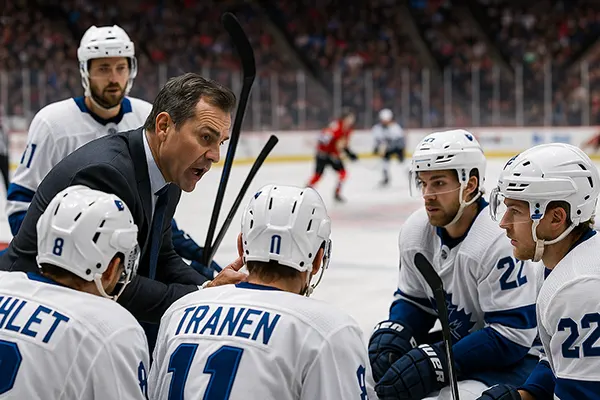How Roster Changes Impact Betting Odds in the NHL: Injuries, Suspensions, and Player Trades

Roster adjustments are an integral part of professional hockey, and their influence on betting odds can be substantial. In the NHL, where games are often decided by fine margins, even a single player’s absence can shift the outcome. Understanding how bookmakers and bettors respond to such changes is crucial for making informed wagers in 2025.
Key Positions and Their Impact on Betting Lines
The role of specific players in a team’s structure determines how drastically odds may change. Goalkeepers, for instance, are the cornerstone of any hockey team. When a starting goalie suffers an injury or is suspended, bookmakers react swiftly—odds can swing by as much as 20% in some cases. Backup goalies might lack the consistency or experience needed to maintain defensive stability.
Defencemen also have a critical influence, particularly those who lead the blue line and play in both power-play and penalty-kill units. Losing a top defender often reduces a team’s ability to control puck possession and maintain tactical discipline. This can lead to higher goal totals in matches, impacting the over/under markets.
Key forwards—especially top-line centres and playmakers—affect scoring potential. When these players are traded or unavailable, the team’s offensive rhythm changes. Bettors should track expected line combinations, which can alter the balance between offensive and defensive strategies.
Evaluating Injuries and Official Information Sources
Accurate information is vital when evaluating roster changes. Bettors should rely on verified NHL injury reports, official team press releases, and reputable sports journalists. In 2025, platforms such as NHL.com, The Athletic, and Sportsnet continue to offer the most trustworthy updates. Social media can provide early leads, but bettors must verify data before acting on it.
Unverified sources or fan-run accounts often spread premature or misleading updates. Betting based on unconfirmed news can result in poor odds and losses. It is advisable to cross-check information across multiple outlets before placing a wager, particularly when the injury involves high-profile players.
Timing is also key: late-breaking news within an hour before the game may not be fully reflected in odds, giving attentive bettors a potential edge if they act quickly but cautiously.
Real Examples of Line Shifts Caused by Roster Changes
One of the most striking examples occurred in early 2024 when the Toronto Maple Leafs’ starting goalie suffered a lower-body injury just before a playoff series. Oddsmakers immediately adjusted the team’s odds from 1.80 to 2.40 for the next match. Bettors who anticipated the defensive vulnerability capitalised on this opportunity by backing the opponent.
Another case involved a mid-season trade in the Colorado Avalanche, where a top-line forward was exchanged for a defensive prospect. While initially overlooked by casual bettors, the trade led to a noticeable decrease in team scoring rate. Those monitoring analytics data were able to predict lower-scoring outcomes and adapt their strategies accordingly.
Injuries to key defenders often raise the total goal line in betting markets. For instance, when a team’s primary shutdown defenceman is unavailable, bookmakers may increase the over/under line from 5.5 to 6.5, anticipating a more open game.
Adapting Bets Before Puck Drop
Experienced bettors understand that last-minute roster updates can redefine the market. The most effective strategy is to monitor team news until shortly before puck drop and use live betting to react to confirmed lineups. Odds often fluctuate rapidly after official announcements, meaning timing and market awareness are crucial.
Using real-time odds comparison tools helps identify discrepancies between bookmakers. Some sites are slower to adjust, offering short windows of value. However, acting impulsively can be risky—always verify the reason behind the odds movement.
For larger bets, consider line movement trends over time. A gradual shift usually indicates collective market confidence, whereas sudden changes often point to a single breaking event, such as an injury or lineup confirmation.

Mitigating Risks of False Reports and Rumours
False injury reports and fake insider news have become more common in 2025, as misinformation spreads rapidly through social media. Bettors should avoid reacting emotionally to such content. Trustworthy information comes only from verified team accounts, league statements, and established media outlets.
Bookmakers themselves now employ analysts who verify public data. When a false report circulates, markets may temporarily overreact, creating inflated odds. Smart bettors can take advantage of these overcorrections by waiting for official confirmation before placing wagers.
In the long run, maintaining a disciplined and analytical approach—tracking player performance, team chemistry, and lineup trends—yields better results than reacting impulsively to every rumour or update.
Building a Reliable Betting Routine
To navigate roster changes effectively, establish a daily routine of checking injury databases and trusted hockey analytics platforms. Use advanced statistics such as expected goals (xG) and player efficiency ratings to assess potential impact. Over time, these insights allow bettors to distinguish between minor absences and major disruptions.
Professional bettors often automate parts of this process, using alert systems that track verified roster updates from official sources. This helps minimise delays and ensures decisions are based on factual, timely data.
Ultimately, the goal is not to predict every outcome but to develop a consistent, informed approach that accounts for the fluid nature of team sports like hockey. By combining data verification, market observation, and disciplined decision-making, bettors can stay one step ahead of unnecessary risk.




